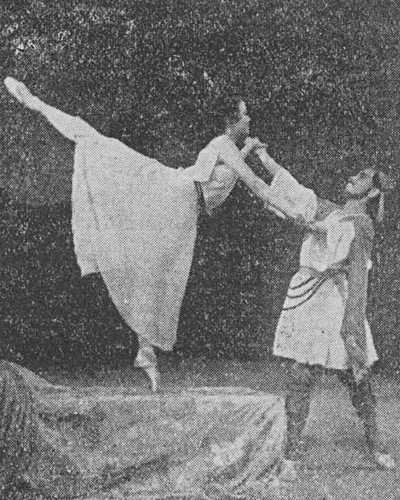|
 |
|
Pai Shu-hsiang as Medora and Liu Ching-tang as Conrad in a pas de deux in the second act of The Corsair |
In 1954 when the Moscow Stanislavsky and Nemirovich-Danchenko Musical Theatre presented Tchaikovsky's Swan Lake in Peking, the first full-length ballet ever performed by a first-rate company in China, someone asked the organizer of the new Peking School of Dancing when we could hope to see a classical ballet performed by Chinese dancers.
The answer was: "Perhaps in six or seven years or so!"
That seemed a reasonable estimate in a country that did not have a single classical ballet group before. Reality, however, has outstripped dreams in this as in so many other spheres.
In 1957, the ballet school put on Vain Precautions by Gertel. True, that was very much a "student production" but it was a full-length ballet nonetheless. In July last year, the school put on Swan Lake with the enthusiastic help of P. A. Gusev, the veteran Soviet choreographer. He followed the Musical Theatre's version based on the original Petipa choreography but with a new prologue and some significant alterations. Choreography, costuming and general production, therefore, had expert guidance. The dancing naturally did not compare with the skilled artistry of the Musical Theatre, but there was a spirit and sincerity in it that compensated for much. Certainly no one was disappointed in the performance. Most were pleasantly surprised. Peking had its classical ballet.
Last May the school produced The Corsair by Adolphe Adam, and scored another hit. This played to full houses until withdrawn at the end of May to make way for rehearsals for a new season of Swan Lake.
With The Corsair, the school has the beginnings of a repertoire. This production, also supervised by Gusev, follows the adaptation of the original ballet made by the Soviet dramatist Slonimsky. This gives a more close-knit, logical structure to the action. Medora, a young girl in a Greek fishing village, saves the life of a sailor, Conrad, who later, with his comrades, rescues her and her friends after they have been captured by slave traders and sold to a petty tyrant.
The story gives plenty of scope for vigorous dancing among the corsairs and pirates, for exotic and pathetic character dances by the slaves and fair victims, and drama in the clash of wills and power between Conrad and the Governor. Medora and her beloved, The Corsair, have some lyrical pas de deux.
Pai Shu-hsiang, who danced Odette-Odile in Swan Lake, makes an appealing Medora. The garden interlude in the third act gives a chance for the entire corps de ballet of forty to show its paces which it did with grace and gusto.
The whole ballet was danced with verve, charm and great sincerity. Every performance of the troupe shows steady improvement; its technique is improving rapidly. The male dancers, especially, show increasing strength and assurance in their roles. | 